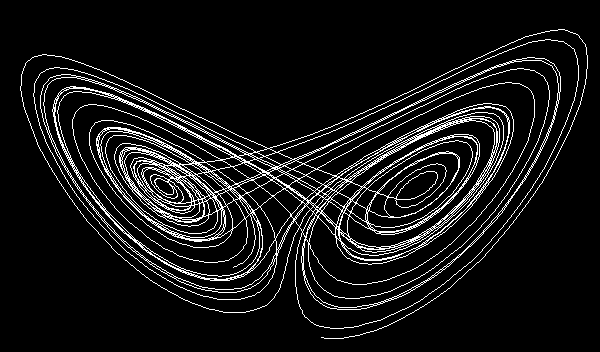
| The story started in 1889 with Henri Poincar� (1854-1912). He produced a paper on the Three-body Problem. That was the first glimpse of Chaos Theory (CT). He used the concept of a Phase Space which is a velocity versus position plot. But plotting the whole phase space is a daunting task, so Poincar� looked at a 'slice' of the phase space. This slice is now called a Poincar� Section. Such a section contains lots of points. And by observing these points, we can detect trends or chaotic behaviours. His 200-page paper was error-ridden and had to be recalled for correction. it is during this second look that he identified a pattern in the Poincar� Section. Some regions became dense with points, while others had none. It soon became clear there is no way to predict the orbit of the bodies far into the future. The resulting 270 pages was published in Acta Mathematica. However, his work was not recognized as an indication of a new Science (or Mathematics) until the 1970s. |  |
An object important to CT is the 'Attractor'. An Attractor can be thought of as the final state of a phenomenon. The simplest example of an attractor is a point. If you release a ball from the brim of an inverted cone, the ball will settle at the vertex of the cone. The vertex is thus an attractor. Another common attractor is termed a 'Limit Cycle'. An example of this is our heartbeat. After an exercise, our heartbeat starts slowing down until it settles into a regular beat. If there are two limit cycles, we get a torus instead of a circle. These attractors are however well-behaved, i.e. they don't give rise to chaos. Strange attractors are different, they are an integral part of chaos.
 |
In 1961, meteorologist Edward Lorenz (1917-) found that extremely small changes in initial conditions had a significant effect on the weather. He plotted phase space and observed that it looked like the wings of a butterfly. Although he did not name it a 'Strange Attractor', this is the first time such an attractor is observed. He had discovered the famous Lorenz Attractor or Lorenz Butterfly. In fact, it is coincidental that an appropriate example of small perturbations affecting the weather is that "butterflies flapping their wings in Mexico may result in a tornado in Texas". |
Another strange attractor, H�non Attractor, was discovered in 1962 by French astronomer Michel H�non (1931-). He discovered this 'banana-shaped' attractor while working on star clusters. But it was only in 1976 that he realized he had got a strange attractor. Stephen Smale (1930-) showed in the 1960s that the phenomenon of strange attractors can be explained by a topological transformation in phase space.
In the 1970s, Australian Robert May (1936-) used the Logistic Equation to show that biological populations could become chaotic. He discovered the Logistic Attractor as a result. His attractor is produced via a Bifurcation process, in which a state splits into two other states. Mathematician Mitchell Feigenbaum (1944-) followed up on May's study and found there is order in the chaos May observed. The route to chaos was universal and there is a universal constant (approx. 4.66920160) involved. A few years late, the relationship between CT and Fractal Theory was forged. Incidentally, all strange attractors are fractals.
In the late 1970s, Jack Wisdom showed that the gaps in the asteroid belt of our solar system are due to chaos. Soon, more and more astronomical phenomena were explained using CT with great success. In particular, Saturn rings, galaxy clusters, superclusters (clusters of clusters of galaxies) and blackholes are found to be related to CT.
To demonstrate the use of CT, consider the problem: why does a flock of birds
seem to fly in harmony; why don't they collide with each other? In 1997,
Zoologist Frank H. Heppner used CT to explain this phenomenon. He modeled the
flocking behaviour by 4 simple rules:
1. The birds are
attracted to a focal point or roost.
2. They are attracted
to each other.
3. They want to maintain a fixed speed.
4. Flight paths are altered by random occurrences, such as
gusts of wind.
By varying the intensity of these rules, he could make his triangles (which represent the birds) flock in a bird-like fashion. This model could well be applied to other similar phenomena, such as the movement of a school of fish or a buffalo stampede. We'll certainly see more of CT in action in the future, in fact, it is presently a booming area of interest.
The word 'chaos' was coined in 1976 by physicist James Yorke.
Return to Maths Homepage